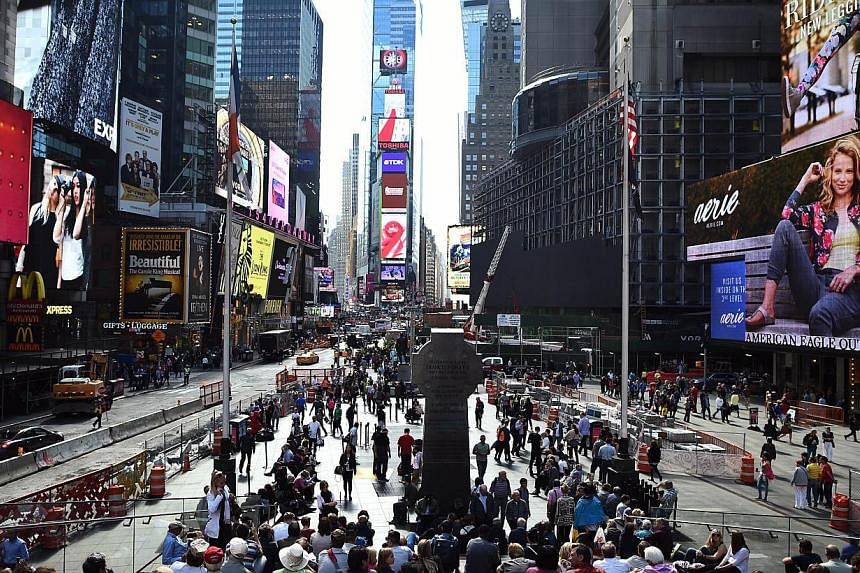WASHINGTON (AFP) - US economic growth was robust in the third quarter, according to the first government estimate on Thursday, appearing to underscore the Federal Reserve's decision to end its asset-buying stimulus programme.
The world's largest economy expanded at an annual rate of 3.5 per cent in the July-September period as defence spending surged and exports climbed, narrowing the trade gap, the Commerce Department said.
Economists had expected slower third-quarter growth, with the consensus at 3 per cent, after the robust 4.6 per cent expansion in the second quarter. The economy contracted 2.1 per cent in the first quarter largely due to severe winter weather.
"Growth above 3 per cent in four of the past five quarters is starting to look like a trend," said Ian Shepherdson of Pantheon Macroeconomics.
The GDP report came a day after the Federal Reserve announced it was winding up its asset-purchase programme this month, after pumping trillions of dollars into the economy in the past six years to shore up the recovery from the Great Recession.
In announcing its decision on Wednesday, the Federal Open Market Committee expressed increasing confidence in a modestly expanding economy and cited "substantial improvement" in the labour market, where the unemployment rate has fallen to 5.9 per cent and jobs growth has averaged 227,000 a month so far this year.
Data released by the Labour Department on Thursday showed new claims for unemployment insurance, a sign of the pace of layoffs, were holding to the recent low levels that have bolstered the tightening jobs market.
The healthy GDP numbers fuelled speculation that the central bank could hike interest rates earlier than the mid-2015 target that it has signalled up to now.
"If growth continues at this pace - we think it will - the first Fed tightening could easily come in the spring, especially if wage gains start to pick up," Shepherdson said.
The Commerce Department cited slower business investment and consumer spending for the deceleration in growth in the third quarter.
The economy's key driver, consumer spending, rose 1.8 per cent after increasing 2.5 per cent in the prior quarter.
Disposable personal income growth also stumbled, growing 2.7 per cent, down from a 4.4 per cent second-quarter rise.
A shrinking trade deficit added 1.32 percentage point to growth, the best gain since the 2009 second quarter. Exports of goods and services increased 7.8 per cent, while imports fell 1.7 per cent.
But Robert Brusca, chief economist at FAO Economics, raised concerns that "the rising dollar and weak growth abroad will be undercutting US exports and adversely affecting US manufacturing sector that had been a source of some strength."
Overall government spending rose 4.6 per cent following an increase of 1.7 per cent in the prior quarter.
The federal government component jumped a hefty 10 per cent, led by a 16 per cent surge in defence spending.
"We can't really think that this is good news that US growth is being underpinned and boosted by military activity," Brusca said.
Inflation slowed in the second quarter to well below the Fed's 2 per cent comfort zone. The personal consumption expenditures price index, the central bank's preferred inflation measure, fell to 1.2 per cent from 2.3 per cent in the prior quarter.
"Looking through the quarterly volatility, caused to a large extent by inventories and trade, consumer spending will remain the main growth engine of the US economy. It should be well supported by the ongoing improvement in the labor market, and the anticipated pick-up in wages," said Harm Bandholz of UniCredit Economics.
Research firm Macroeconomic Advisers said the lower-than-expected inventory investment, which subtracted 0.57 percentage point from GDP, points to less of a decline in the fourth quarter, while the leap in defence spending suggested "some reversal" in the fourth quarter.
"On balance, this left our tracking forecast of fourth-quarter GDP growth unchanged at 2.4 per cent," it said.

